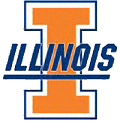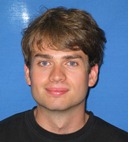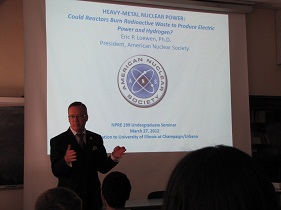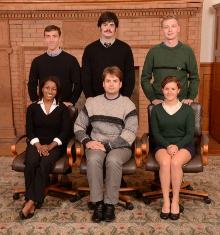The ANS Student Section of the University of Illinois at Urbana-Champaign
 American Nuclear Society President Eric Loewen visited the ANS student section at the University of Illinois on Tuesday, March 27, followed by dinner with the Central Illinois ANS local section. This event was part of Loewen's "March Madness" speaking tour, building toward the 2012 ANS Student Conference (which begins today in Las Vegas). The occasion gave ANS Nuclear Cafe a chance to catch up with Valentyn Bykov, president of the ANS student section at the University of Illinois at Urbana-Champaign, to discuss the section and its activities.
American Nuclear Society President Eric Loewen visited the ANS student section at the University of Illinois on Tuesday, March 27, followed by dinner with the Central Illinois ANS local section. This event was part of Loewen's "March Madness" speaking tour, building toward the 2012 ANS Student Conference (which begins today in Las Vegas). The occasion gave ANS Nuclear Cafe a chance to catch up with Valentyn Bykov, president of the ANS student section at the University of Illinois at Urbana-Champaign, to discuss the section and its activities.
Social events

- Bykov
Excursions

- Dr. Loewen addresses the Illinois ANS Student Section
Outreach
"We also make sure to stay in touch with people outside of the NPRE Department and the nuclear industry, mainly through outreach events," he said. "When we ask people what do they think when you say nuclear engineering, we often hear about nuclear weapons, cooling towers and (more often than you'd think) the dangerous health effects of the microwave oven radiation. Our goal is to inform and educate, but also share why we think that industry nuclear is an interesting and exciting career choice. We organize and assist with several
Boy Scout merit badge events, in which young scouts learn about the science behind nuclear power and related career choices. Every March we hold a series of presentations and demonstrations during our university's Engineering Open House, a two-day event during which over 20,000 people visit campus to see various engineering demonstrations created by students. We also try to be present during various non-engineering events; for example, we have a table next to other student organizations in an event organized during 'Mom's weekend,' in which students and their visiting moms can see what various student organizations do on campus. Being usually the only engineering organization present at this event, our interactive demonstration of radiation sources is very popular. Many of the visitors want to talk to us about the nature of our organization, potential careers, details about Fukushima, and nuclear power in general."
The future

- Valentyn Bikov, Arthur Talpaert, Jason Peck, Eric Loewen, Thomas Dolan, Rizwan Uddin, Barclay Jones
"I feel like our ANS section is an extension of the students," he added. "At times various students have an idea for an interesting event or a trip, and instead of leaving the organization up to the (already very busy) NPRE Department, the ANS student section will step in and handle everything. This gives more power to the students, as we can spread the word about the idea and, if there's sufficient interest, organize the whole event without the need for the department to get involved."
"This also works the other way around, when the department asks or encourages us to set up an event to address an issue they hear about in student feedback forms," Bykov said. "For example, our university no longer has an operating research reactor (our TRIGA was shut down in the 1990s for political reasons), and many students feel they are 'missing out' on the related experiments. Therefore, our department suggested-and our student section is currently in the process of organizing-a visit to a university that has a working reactor, during which we would perform experiments to gain experience with research reactor operation. The goal is to first organize the visit and offer it simply as a trip for interested individuals, then in the future hopefully make the visit more frequently than once in a semester, and offer some kind of course credit in return. The whole effort is currently organized primarily between our ANS student section and the ANS student section at the Missouri University of Science and Technology."

- The Illinois ANS student section board. top row: Michael Cunningham, Robert Geringer, Cody Morrow; bottom row: Talisa Chambers, Valentyn Bykov, Molly Bilderback; not pictured: Carlos Altamirano
"Our ANS student section provides many ways in which to get involved, whether it's getting advice on what class to take next semester, meeting nuclear power plant workers and talking to them about their job, practicing one's teaching abilities with children and the general public, or one of the many other ways for nuclear engineering students to get involved in the 'big picture,'" he concluded.
___________________________________










